Revision Notes: Water Resources | Environmental Management for Grade 10 PDF Download
| Table of contents |

|
| Water Resources in India |

|
| Means of Irrigation |

|
| Modern Methods of Irrigation |

|
| Rainwater Harvesting |

|
Water Resources in India
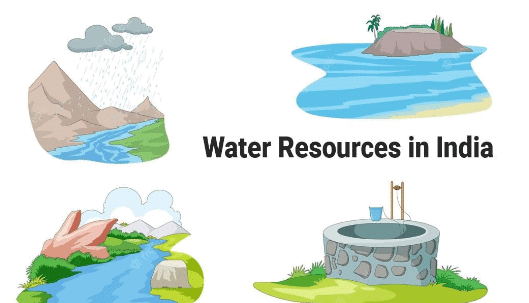
India is home to a vast array of rivers, lakes, lagoons, and ponds, which collectively represent 4% of the world’s water resources. Water in India is primarily utilized for drinking, irrigation, household needs, and industrial purposes. Currently, 92% of water is used for agriculture, 2% for industries, and the remaining 6% for drinking and household purposes.
Irrigation refers to the artificial process of watering agricultural plants using tanks, wells, and canals. Agriculture in India heavily relies on rainfall for crop production. To lessen this dependence, various tanks, wells, and canals have been established, along with the construction of several multipurpose dams. The focus on developing artificial irrigation methods is due to several reasons:
- Uncertainty and Uneven Distribution of Rainfall: Rainfall in India is irregular and unpredictable. Sometimes, the monsoon arrives early, while other times it is delayed, and rainfall is not uniform across the country. This unpredictability makes it essential for farmers to have alternative water sources for irrigation.
- Nature of Soil: Different soils have varying water requirements. For instance, clayey soil retains moisture well and does not need intensive irrigation, whereas sandy loamy soil requires more frequent watering.
- Nature of River: Many rivers in India are not perennial. In central and southern India, most rivers have water only for four months during the monsoon, necessitating a robust irrigation system.
- To Maximize Production: With the significant increase in the country’s population, crop production needs to be enhanced to meet the growing demands. This requires advanced and reliable irrigation methods.
Means of Irrigation
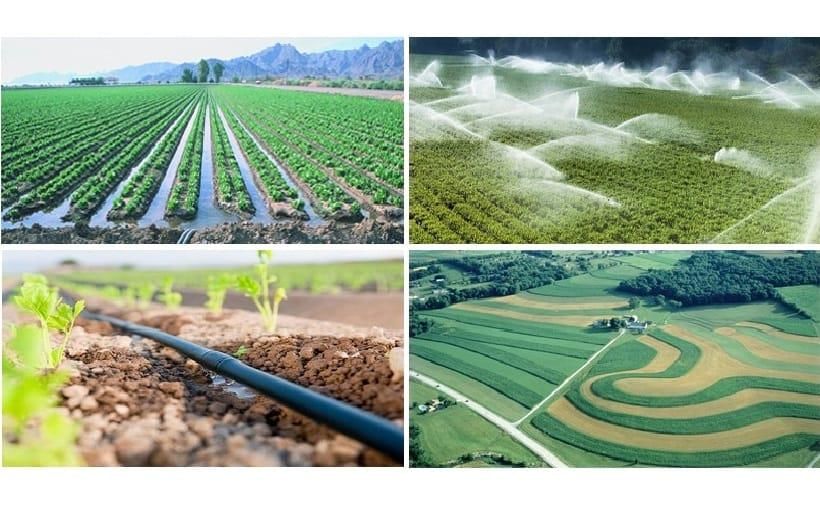
In India, the main traditional methods of irrigation include wells, tanks, and canals.
Wells
A well is a small hole dug into the ground to access water from the subsoil for irrigation and other purposes. This is a traditional method of irrigation, typically found in areas with a high groundwater table.
Well irrigation is commonly practiced in alluvial plains where the soil is soft and easy to dig. In India, well irrigation is prevalent in states such as Uttar Pradesh, Goa, Punjab, Haryana, Bihar, Rajasthan, Gujarat, Maharashtra, Andhra Pradesh, Karnataka, and Tamil Nadu.
Water from wells can be lifted using various methods:
- Persian Wheel Method: This device features a vertical wheel with buckets attached to its rim. Animals like buffaloes and camels rotate the wheel, filling the buckets with water, which is then emptied into a trough for transportation to fields.
- Lever Method: An economical and efficient way to lift water from wells, commonly used in Bihar and Andhra Pradesh.
- Inclined Plane Method: Also known as mhote, this method involves using a pair of bullocks to lift water from wells.
- Table Wells: In this method, power-driven pumps are used to lift water from tube wells at depths below 15 meters.
Advantages of Using Wells
- Low Cost: Wells can be dug at a low cost, making them accessible to poor farmers.
- Versatile Use of Oxen: Oxen used for ploughing can also be utilized for drawing water from wells, increasing efficiency.
- Deep Water Access: Pumps and tube wells can be employed to lift water from great depths, providing access to deeper water sources.
Disadvantages of Well Irrigation
- Difficult Excavation: Digging wells in hilly regions or stony areas can be challenging, limiting their use in such terrains.
- Water Table Dependency: Wells are susceptible to drying up if the water table drops, making them unreliable in some cases.
- High Operating Costs: The use of electricity and diesel to operate tube wells can make irrigation expensive, posing a financial burden on farmers.
Tanks

A tank is a man-made reservoir created by constructing a dam across a stream to collect and store water. This stored water is then transported to agricultural fields through narrow channels for irrigation purposes.
Usage of Tanks in Peninsular India
- Tanks are commonly used for irrigation in peninsular India, particularly in states like Maharashtra and Gujarat.
- They are extensively utilized in the Deccan region due to several favorable factors:
- Natural Depressions: The Deccan has numerous natural depressions where tanks can be easily constructed to store water.
- Non-Perennial Rivers: The rivers in this region are not perennial, meaning they dry up during the summer, making tanks a reliable source of water.
- Stony Terrain: In the stony areas of the Deccan, digging wells is challenging. However, tanks can be built by creating small stone dams in the depressions where rainwater collects.
Regions Practicing Tank Irrigation
Tank irrigation is widely practiced in several states, including:
- Andhra Pradesh
- Tamil Nadu
- West Bengal
- South Rajasthan
- South Bihar
Advantages of Tank Irrigation
- Seasonal Rainfall: Tank irrigation is beneficial in Deccan regions where rainfall is seasonal and unpredictable.
- Rocky Terrain: In the rocky landscape of the Deccan Plateau, constructing wells and canals is challenging. Tanks, however, provide a viable solution for irrigation in such areas.
- Rainwater Harvesting: Tanks allow for the storage of rainwater that would otherwise run off and be wasted. This stored water is then used for irrigation purposes.
Disadvantages of Tank Irrigation
- Siltation: Tanks are prone to siltation and require regular desilting to maintain their capacity and effectiveness.
- Dependability: In the event of insufficient rainfall, tanks can remain dry, making them an unreliable source of irrigation.
- Evaporation and Infiltration: Due to their large surface area and shallow depth, water in tanks is susceptible to evaporation and infiltration.
- Land Use: Tanks can occupy large areas of land that could otherwise be used for crop cultivation.
- Labor and Cost: The process of lifting water from tanks and transporting it to fields is labor-intensive and costly.
Canals

Canals play a significant role in irrigation across India. There are two primary types of canals:
- Inundation Canals: These canals are directly sourced from large rivers and are used to divert water when the river is at a high level, particularly during floods. However, their utility is limited due to this dependency.
- Perennial Canals: These canals are derived from perennial rivers through the construction of small dams and barrages that help regulate the river's flow. The majority of canals in India fall under this category.
Some notable canals in India include:
- Punjab and Haryana: Upper Bari Doab, Bist Doab, Sirhind, Bhakra, and Western Yamuna Canals
- Rajasthan: Indira Gandhi Canal and Bikaner Canal
- Uttar Pradesh: Eastern Yamuna Canal, Sharda Canal, Ramganga Canal, and Betwa Canal
- West Bengal: Damodar Canal and Mayurakhi Canal
In South India, canals are widely used for irrigation, with significant projects like the Nagarjunasagar and Tungabhadra in Andhra Pradesh. For instance, one-third of Tamil Nadu's net irrigated area relies on canal irrigation, and the state of Mizoram depends entirely on canals for its irrigation needs.
Advantages of Canal Irrigation
- Canal irrigation is crucial in areas with low rainfall, providing necessary water for agriculture.
- In arid regions like Rajasthan, canals support the cultivation of high-yield crops, contributing to robust agricultural outputs.
- Canals have transformed vast areas of Punjab and Haryana into agricultural powerhouses, playing a pivotal role in the Green Revolution.
- In Tamil Nadu, where winter rainfall is common, canals ensure water supply during the summer months, compensating for the lack of rainfall.
Disadvantages of Canal Irrigation
- In canal irrigation systems where the water table is only a few feet below the surface, alkaline salts can rise to the surface. This process can contaminate the soil, making it unproductive for agriculture.
- Waterlogging in canals can lead to reduced soil absorption capacity. This issue can harm crops, especially in areas lacking an effective drainage system.
Major Drawbacks of Conventional Methods of Irrigation
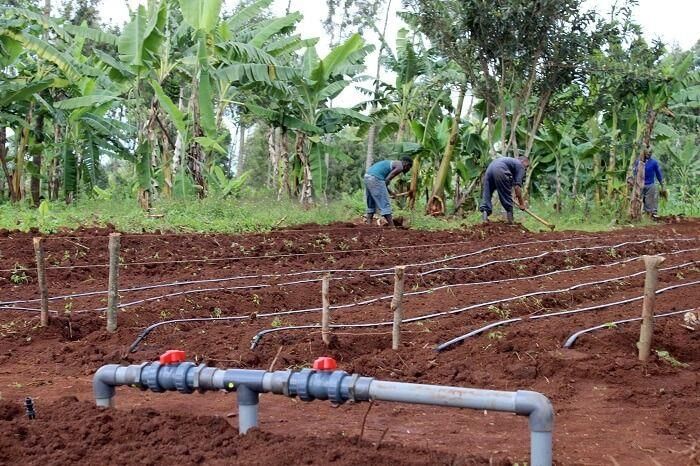
- Land Use: Conventional irrigation methods require about 10-15% of agricultural land to be used for preparing water channels, which reduces the effective area available for cultivation.
- Evaporation and Siltation: In tanks and canals, water evaporation can lead to soil siltation, reducing the quality and fertility of the soil.
- Waterlogging: Low-lying fields often receive excess water, resulting in waterlogging. This condition leads to the accumulation of salt, which damages soil quality.
- Water Wastage: Conventional irrigation systems do not use water efficiently, leading to significant water wastage.
Modern Methods of Irrigation
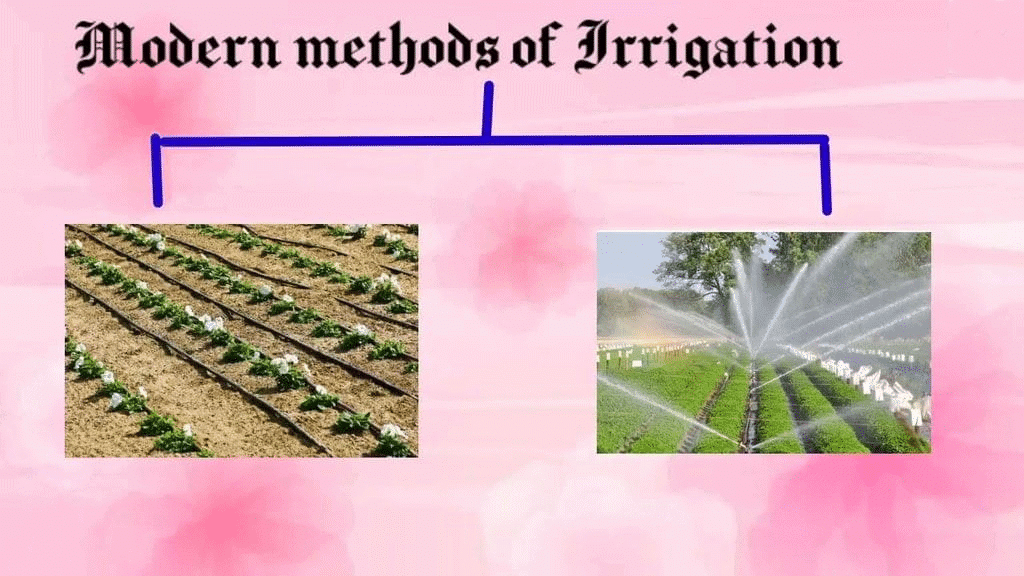
- Furrow Irrigation: This method involves digging furrows or trenches between rows of crops to distribute water. It is a form of surface irrigation and is effective in areas where water is readily available.
- Spray Irrigation: In this method, water is sprayed over the agricultural field using spray guns. Spray irrigation is an efficient way to use water for irrigation. However, it is expensive due to the need for complex machinery, and there is a risk of overwatering, which can lead to plant diseases.
- Drip Irrigation: Drip irrigation delivers water directly to the crops through perforated pipes placed between rows of plants. This method minimizes evaporation and conserves water, making it one of the most advanced and efficient irrigation systems.
- Need for Water Conservation: With the rapidly growing population, there is an urgent need to conserve water. Overexploitation of groundwater has resulted in declining water tables. Additionally, the demand for water for domestic and industrial use has increased, while many water bodies such as rivers, lakes, and tanks have become polluted and are no longer suitable for basic purposes.
Rainwater Harvesting
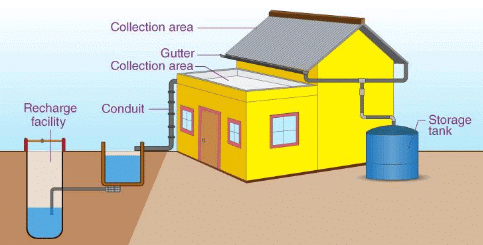
Rainwater harvesting involves collecting rainwater for use before it reaches the ground. This process typically begins with gathering rainwater from rooftops through pipes, which is then stored in underground storage structures.
Mechanism of Rainwater Harvesting
- Rainwater is first collected from the rooftop using a PVC pipe.
- The collected water is filtered using a combination of sand and bricks.
- After filtration, the water is directed to a sump for immediate use or transported to a well or other dug structure on the premises.
- Water stored in the well can be used later for domestic purposes and also helps recharge the water table.
Elements of Rainwater Harvesting
- Catchment: This is the area or surface that directly receives rainwater.
- Conduits: These are the pipelines or drains that carry rainwater from the catchment to the harvesting system.
- Storage Facility: Rainwater can be stored in containers made of reinforced cement concrete (RCC), masonry, or plastic water tanks.
- Recharge Facility: Rainwater harvesting also contributes to recharging groundwater aquifers.
Recharging Groundwater Aquifers
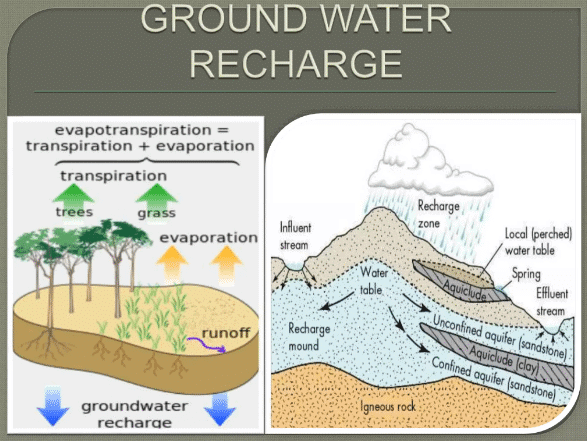
Groundwater aquifers can be recharged using various methods, including:
- Digging of Bore Wells: Bore wells are drilled to access and recharge groundwater.
- Recharge Pits: These are excavated pits designed to facilitate the infiltration of water into the ground, promoting recharge.
- Percolation Pits: Similar to recharge pits, percolation pits help in the percolation of water through the soil layers, aiding in groundwater recharge.
- Recharge Trenches: Trenches are dug to collect and direct water for recharge purposes, enhancing the groundwater levels.
|
2 videos|38 docs
|
FAQs on Revision Notes: Water Resources - Environmental Management for Grade 10
| 1. What are the different types of wells used for water extraction? |  |
| 2. How do water tanks contribute to water resource management? |  |
| 3. What are the main functions of canals in water resource management? |  |
| 4. What is the mechanism of rainwater harvesting? |  |
| 5. How does recharging groundwater aquifers benefit the environment? |  |




















